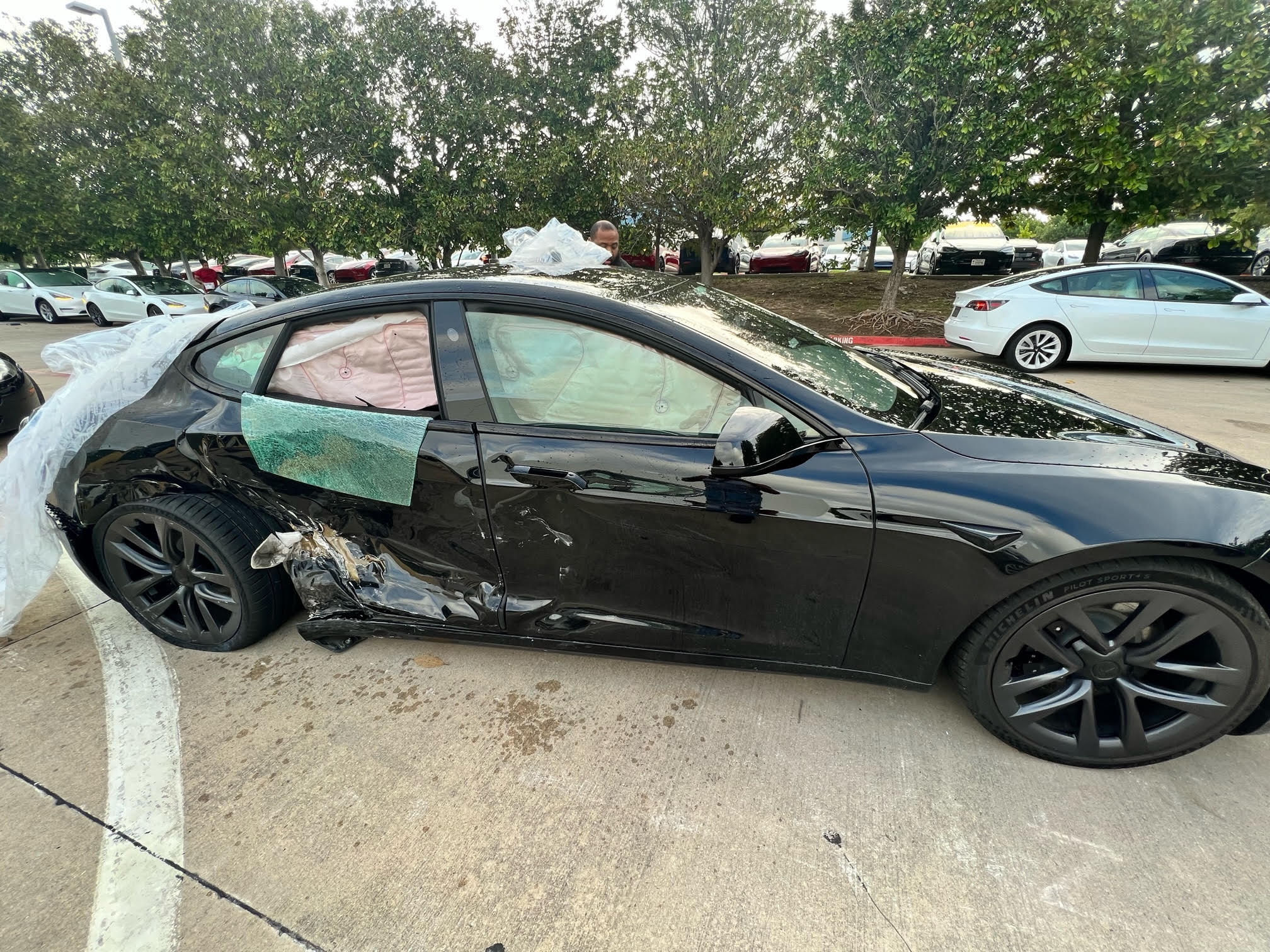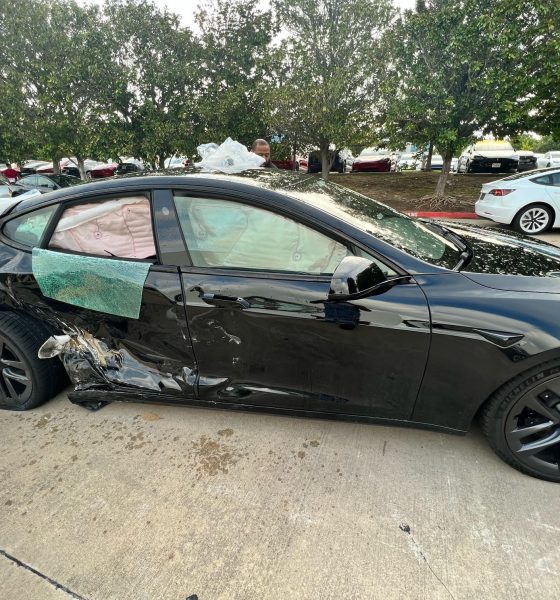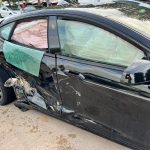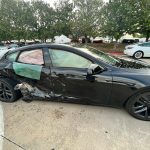

News
Tesla Model S Plaid totaled by Service Center employee, leaving owner without answers
Update 9/9/22 12:32 P.M. EST: Jeff contacted me personally and told me Tesla has officially shipped a Model S Plaid identical to his now-totaled vehicle. “I just got a call from Tesla, a clone of my Model S Plaid is on the truck heading for Texas as I text you today.”
A $155,000 Tesla Model S Plaid was totaled several days after the owner dropped the vehicle off for a Service appointment. Now, the owner is attempting to find answers.
After dropping his Model S Plaid with only a few thousand miles off at the Plano, Texas Tesla Service Center on Wednesday, August 24, owner Jeff said he received a call on Tuesday, August 30, from an employee. “We have some bad news,” Jeff heard over the phone. “Your car was totaled.”
“I thought it was a joke,” Jeff told Teslarati in an interview. “I found out very soon it was not a joke.”
After arriving at the Service Center the next day, on Wednesday, August 31, Jeff found his black Model S Plaid in the parking lot. The rear passenger door smashed in, and visibility into the vehicle was limited due to many airbags in the car being deployed. The vehicle had been t-boned by another car traveling just two blocks from the Service Center, located at 5800 Democracy Drive in Plano. The repair had already been completed and an employee was driving the vehicle around to ensure it was completed properly.
- Credit: Teslarati
- Credit: Teslarati
However, the driver of the Model S Plaid, a 31-year-old employee of the Plano Service Center, failed to yield the right of way at a stop sign and was hit by another car. The Model S Plaid was totaled in the accident.
Initially, Jeff was interested in receiving a new car, of course, and there happened to be an exact match of what his Plaid Model S once was at another showroom in the State. He was offered that vehicle on Wednesday, but by Thursday, that had changed. Tesla said they would likely go through insurance, meaning it would take nearly three weeks to get Jeff his vehicle.
The Legalities of the Situation
Teslarati spoke to insurance experts and liability attorneys, who told us the situation in which the vehicle was totaled and determining liability is what truly matters. The fact that this is a customer’s car and an employee crashed it is irrelevant until liability is determined.
We obtained the police report through the City of Plano, which revealed the employee at the Tesla Service Center was at fault. Jeff also told us that when he spoke to the employee driving the vehicle at the time of the accident, they admitted that the accident was his fault.
The report states that the driver of the Model S was officially charged with Failure to Yield the Right of Way at a Stop Sign. The investigating officer describes the accident in the report:
“UNIT 1 WAS STOPPED AT A STOP SIGN IN LANE 2 E/B DEMOCRACY DRIVE FOR PARKWOOD BLVD. UNIT 1 THEN PROCEEDED THROUGH THE INTERSECTION. UNIT 2 WAS N/B PARKWOOD BLVD IN THE RIGHT LANE. DUE TO UNIT 1 FAILING TO YIELD RIGHT OF WAY AT A STOP SIGN TO UNIT 2, THE FRONT END OF UNIT 2 STRUCK THE RIGHT BACK QUARTER OF UNIT 1.”
Illustration of the accident: Unit 1 is the Tesla Model S, while Unit 2 is the Audi A5. Unit 1 is the vehicle at fault, City of Plano officials told Teslarati. (Credit: Teslarati)
The report, obtained by Teslarati, shows there was a second occupant in the Tesla at the time of the crash. The driver is 33. The passenger is 31. Additionally, the Audi A5 that collided with the Tesla was being driven by a 62-year-old who was taken to Plano Presbyterian Hospital.
What’s Next
Tesla has been tight-lipped to Jeff, saying they would be in touch with him regarding the accident within the next three weeks. Tesla may have been attempting to determine liability as its employee who was driving the vehicle may not necessarily be responsible for the accident, especially considering he was t-boned while navigating through an intersection. However, the report filed by the investigating officer determined that the driver of the Tesla was at fault, and the fact that the employee also expressed to Jeff that the accident was his fault would eliminate Tesla’s need to determine this.
Jeff said Tesla has not offered a loaner or a formal replacement vehicle currently, which makes his situation much more complicated. Teslarati reported last month that Tesla had abolished its policy of offering loaners and Uber credits for some service appointments. However, Jeff’s vehicle is totaled, he is without a replacement, and the accident did not happen while he was driving the car, or even in possession of the Model S Plaid.
As of Tuesday, September 6, Tesla has yet to contact Jeff regarding the accident or any information on a replacement vehicle.
I’d love to hear from you! If you have any comments, concerns, or questions, please email me at joey@teslarati.com. You can also reach me on Twitter @KlenderJoey, or if you have news tips, you can email us at tips@teslarati.com.

Elon Musk
Elon Musk and Tesla AI Director share insights after empty driver seat Robotaxi rides
The executives’ unoccupied tests hint at the rapid progress of Tesla’s unsupervised Robotaxi efforts.

Tesla CEO Elon Musk and AI Director Ashok Elluswamy celebrated Christmas Eve by sharing personal experiences with Robotaxi vehicles that had no safety monitor or occupant in the driver’s seat. Musk described the system’s “perfect driving” around Austin, while Elluswamy posted video from the back seat, calling it “an amazing experience.”
The executives’ unoccupied tests hint at the rapid progress of Tesla’s unsupervised Robotaxi efforts.
Elon and Ashok’s firsthand Robotaxi insights
Prior to Musk and the Tesla AI Director’s posts, sightings of unmanned Teslas navigating public roads were widely shared on social media. One such vehicle was spotted in Austin, Texas, which Elon Musk acknowleged by stating that “Testing is underway with no occupants in the car.”
Based on his Christmas Eve post, Musk seemed to have tested an unmanned Tesla himself. “A Tesla with no safety monitor in the car and me sitting in the passenger seat took me all around Austin on Sunday with perfect driving,” Musk wrote in his post.
Elluswamy responded with a 2-minute video showing himself in the rear of an unmanned Tesla. The video featured the vehicle’s empty front seats, as well as its smooth handling through real-world traffic. He captioned his video with the words, “It’s an amazing experience!”
Towards Unsupervised operations
During an xAI Hackathon earlier this month, Elon Musk mentioned that Tesla owed be removing Safety Monitors from its Robotaxis in Austin in just three weeks. “Unsupervised is pretty much solved at this point. So there will be Tesla Robotaxis operating in Austin with no one in them. Not even anyone in the passenger seat in about three weeks,” he said. Musk echoed similar estimates at the 2025 Annual Shareholder Meeting and the Q3 2025 earnings call.
Considering the insights that were posted Musk and Elluswamy, it does appear that Tesla is working hard towards operating its Robotaxis with no safety monitors. This is quite impressive considering that the service was launched just earlier this year.
Elon Musk
Starlink passes 9 million active customers just weeks after hitting 8 million
The milestone highlights the accelerating growth of Starlink, which has now been adding over 20,000 new users per day.

SpaceX’s Starlink satellite internet service has continued its rapid global expansion, surpassing 9 million active customers just weeks after crossing the 8 million mark.
The milestone highlights the accelerating growth of Starlink, which has now been adding over 20,000 new users per day.
9 million customers
In a post on X, SpaceX stated that Starlink now serves over 9 million active users across 155 countries, territories, and markets. The company reached 8 million customers in early November, meaning it added roughly 1 million subscribers in under seven weeks, or about 21,275 new users on average per day.
“Starlink is connecting more than 9M active customers with high-speed internet across 155 countries, territories, and many other markets,” Starlink wrote in a post on its official X account. SpaceX President Gwynne Shotwell also celebrated the milestone on X. “A huge thank you to all of our customers and congrats to the Starlink team for such an incredible product,” she wrote.
That growth rate reflects both rising demand for broadband in underserved regions and Starlink’s expanding satellite constellation, which now includes more than 9,000 low-Earth-orbit satellites designed to deliver high-speed, low-latency internet worldwide.
Starlink’s momentum
Starlink’s momentum has been building up. SpaceX reported 4.6 million Starlink customers in December 2024, followed by 7 million by August 2025, and 8 million customers in November. Independent data also suggests Starlink usage is rising sharply, with Cloudflare reporting that global web traffic from Starlink users more than doubled in 2025, as noted in an Insider report.
Starlink’s momentum is increasingly tied to SpaceX’s broader financial outlook. Elon Musk has said the satellite network is “by far” the company’s largest revenue driver, and reports suggest SpaceX may be positioning itself for an initial public offering as soon as next year, with valuations estimated as high as $1.5 trillion. Musk has also suggested in the past that Starlink could have its own IPO in the future.
News
NVIDIA Director of Robotics: Tesla FSD v14 is the first AI to pass the “Physical Turing Test”
After testing FSD v14, Fan stated that his experience with FSD felt magical at first, but it soon started to feel like a routine.

NVIDIA Director of Robotics Jim Fan has praised Tesla’s Full Self-Driving (Supervised) v14 as the first AI to pass what he described as a “Physical Turing Test.”
After testing FSD v14, Fan stated that his experience with FSD felt magical at first, but it soon started to feel like a routine. And just like smartphones today, removing it now would “actively hurt.”
Jim Fan’s hands-on FSD v14 impressions
Fan, a leading researcher in embodied AI who is currently solving Physical AI at NVIDIA and spearheading the company’s Project GR00T initiative, noted that he actually was late to the Tesla game. He was, however, one of the first to try out FSD v14.
“I was very late to own a Tesla but among the earliest to try out FSD v14. It’s perhaps the first time I experience an AI that passes the Physical Turing Test: after a long day at work, you press a button, lay back, and couldn’t tell if a neural net or a human drove you home,” Fan wrote in a post on X.
Fan added: “Despite knowing exactly how robot learning works, I still find it magical watching the steering wheel turn by itself. First it feels surreal, next it becomes routine. Then, like the smartphone, taking it away actively hurts. This is how humanity gets rewired and glued to god-like technologies.”
The Physical Turing Test
The original Turing Test was conceived by Alan Turing in 1950, and it was aimed at determining if a machine could exhibit behavior that is equivalent to or indistinguishable from a human. By focusing on text-based conversations, the original Turing Test set a high bar for natural language processing and machine learning.
This test has been passed by today’s large language models. However, the capability to converse in a humanlike manner is a completely different challenge from performing real-world problem-solving or physical interactions. Thus, Fan introduced the Physical Turing Test, which challenges AI systems to demonstrate intelligence through physical actions.
Based on Fan’s comments, Tesla has demonstrated these intelligent physical actions with FSD v14. Elon Musk agreed with the NVIDIA executive, stating in a post on X that with FSD v14, “you can sense the sentience maturing.” Musk also praised Tesla AI, calling it the best “real-world AI” today.










